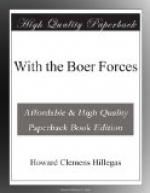No one was surfeited with orders; in fact, the lack of them was more noticeable, and it was well that it was so, for the Boer burgher disliked to be ordered, and he always did things with better grace when he acted spontaneously. An illustration of this fact was an incident at the fight of Modderspruit where two young Boers saved an entire commando from falling into the hands of the enemy. Lieutenant Oelfse, of the State Artillery, and Reginald Sheppard, of the Pretoria commando, observed a strong force of the British advancing towards a kopje where the Krugersdorp commando was concealed. The two men saw that the Krugersdorpers would be cut off in a short time if they were not informed of the British advance, so they determined to plunge across the open veld, six hundred yards from the enemy’s guns, and tell them of their danger. No officer could have compelled the men to undertake such a hazardous journey across a bullet-swept plain, but Oelfse and Sheppard acted on their own responsibility, succeeded in reaching the Krugersdorp commando without being hit, and gave to the commandant the information which undoubtedly saved him and his men from being captured. Incidents of like nature occurred in almost every battle of the campaign, and occasionally the service rendered so voluntarily by the burghers was of momentous consequences, even if the act itself seemed trivial at the time.
A second feature of the Boer army, and equally as important as the freedom of action of its individuals, was its mobility. Every burgher was mounted on a fleet horse or pony, and consequently his movements on the battlefield, whether in an advance or in a retreat, were many times more rapid that those of his enemy—an advantage which was of inestimable value both during an engagement and in the intervals between battles when it was necessary to secure new positions. During the progress of a battle the Boers were able to desert a certain point for a time, mount their horses and ride to another position, and throw their full strength against the latter, yet remaining in such close touch with the former that it was possible to return and defend it in an exceedingly short space of time. With the aid of their horses they could make such a sudden rush from one position to another that the infantry of the enemy could be surrounded and cut off from all communications with the body of its army almost before it was known that any Boers were in the vicinity, and it was due to that fact that the Boers were able to make so many large numbers of captives.




